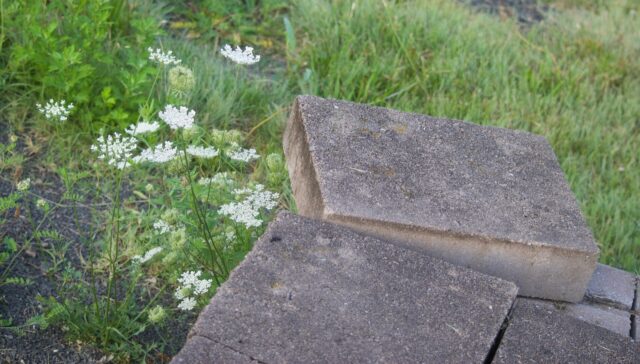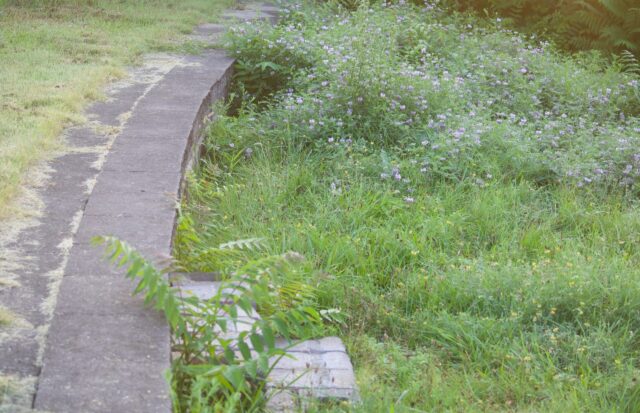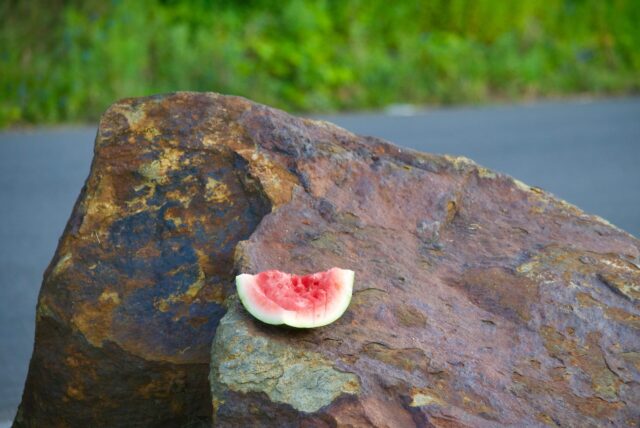Pope Park West is a poster child for wrong-headed decisions.
Bad enough that it was orphaned by I-84, the parcel on Pope Park Hwy #4 has neither sidewalk nor path leading to it.
Had the objective of the park been entirely to preserve (or rehabilitate) a natural space, its inaccessibility would not be an issue. If that were the purpose, there would be no unused and crumbling amphitheater (what is with people building these things? How often do they go unused in parks?! I can list the places in just Hartford where people built and abandoned them). There would not be a large sculpture installation. Nobody would have bothered making a path in the park itself. There wouldn’t be all this grass. Certainly, nobody would bother leaving an outhouse there.

Had it been intended merely as a buffer between highway and former factory buildings, we would see a wider range of flora, some large trees, and a sign or two at the edge of the property explaining that it is a reconstructed wetland. Or something.
There was a recent tree planting on one side of the park, but being in the park often feels like . . . why? It’s so noisy from the highway, and that is the view in one direction. Highway. Not scenic. Not relaxing.
Facing south, the view is repeated illegal dumping along the roadway, especially on the parcel owned by State of Connecticut.
It could be a great place for a dog park. The neighborhood has grown in the last few years. People have dogs. But as is, the park is unpleasant as visitors need to be vigilant about watching where they step — and not because of dog poop. Park maintenance is sporadic and there’s lots of material evidence of intravenous drug use. You see the signs in places that are otherwise underused.

The thing that most tells us there is no interest in this functioning as a place for people or nature: the massive billboard within the park, its messages aimed at highway travelers who should be keeping their eyes on the road.
The park, it seems, is a tribute to the excesses of capitalism, materialism. It’s been made a hard-to-access island by cars and car culture. It’s a place to come and contemplate the ways the automobile assaults our senses. But wait, it gets worse. In 1953, those former factory buildings were still operating as manufacturers and were they ever whiny! Employers complained to the Courant that “it was impossible for them to hire out-of-town workers” because they did not have enough parking. God forbid those companies focus on hiring city residents or encourage carpooling or invite their employees to take public transportation.
This land had already been stripped from park purposes during World War II so that factory workers had parking, though the Park Director explained that this was allowed because there was a national emergency — and those companies had been participating in the war effort. Harder to make a case for in 1953.
The thing is that the park land was given to the City of Hartford with the intent that it be used as a park and only a park. That seems to say no to parking for nearby employees or residents, no for parking even if it is part of a war effort, and no to the presence of billboards. Did 900 students really need to park here to attend a United Aircraft defense training school in 1941? I guess that depends on what you think of war. For me, the answer is “not much.” Build a non-violent society in which people resolve their issues with words. That’s stronger than enabling violence by simply going around with police after the fact to punish. It seems to an extent we’re finally talking about toxic parts of our culture, even if the doing something about it has not come to fruition yet. More people understand that you can’t just blame mass shootings, for instance, on one individual as if he were raised in a bubble and was an exception. Lots of us are talking about the fragility of those who can’t handle rejection or feeling slighted in any way other than using violence, and how this is not acceptable.
But the work to shift a toxic culture is hard and cannot happen overnight. Not when it comes to toxic fragility, not when it comes to the greed of the auto industry.
Look how easily we historically excused degradation of land by having said “but we need it for commuters! we need it for the war machine! we need it to subsidize the manufactured middle-class that will disinvest from Hartford for decades to come!”

Though attempts to heal these wounds began in 2003 with the removal of a road going through the main section of Pope Park, the work is not nearly done twenty years later. People still drive on the bike and walking paths because the City has not installed bollards. There is an overly large parking lot there, yet you can show up on the weekend and find many empty spaces while seeing people driving on park paths and across the lawn — a practice that is unsafe and unpleasant, but which there is no political will to resolve. In 2011, a driver killed a three-year old child in the park’s driveway. A healthier place would have immediately worked on narrowing the driveway and adding speed humps to slow people coming in from the street. There have been no changes. Not so much a sign urging people to slow down and expect children in a park. I’ve suggested to the City that as for the paths that are supposed to be for people walking or cycling only, they put in barriers, whether those are boring concrete blocks, more polished bollards, or those KNOX flower pots. We don’t need police stationed in our parks, and anyway, they sit here already and do not enforce the rules as it is. Prevent the problem, don’t allow it and then police it.
Much of the issue in Pope Park West, though, comes from how most of it was robbed by the State of Connecticut for I-84. Besides the taking of land for it, there’s the ongoing, eye-roll worthy nonsense of City vs. State, which comes up every single time their properties touch. Need a sidewalk plowed? One will make their section immaculate and then spite leave a whole hill of snow at the border, screwing anyone trying to get anywhere. Need vegetation along Capitol Avenue by the overpasses removed so kids can walk to school on a sidewalk instead of out in the street? It becomes a whole debate of who owns what, and then only trimming what the maintenance person believes (or is told) is the property line . . . not a breath beyond it, and often, not even to it. So, when you have a park that was entirely the City of Hartford’s but now has a fuzzy border with the State of Connecticut, and when that park has no sidewalks accessing it . . . it becomes less of a priority to maintain. This exception is when State of Connecticut decides to do mass evictions of people living on their properties, and then installs sky high fences — we get either the blight of litter or the blight of fences that are otherwise not permitted by the City of Hartford, and for a reason.

It can’t entirely be blamed on who the neighbor is. There are similar issues in the Bankside Grove section, and these were documented in the paper going back to at least 1990s — rampant drug use and the litter that goes along with it. And I’ll add, the litter is not helped by the City’s refusal to add trash barrels in these sections. See the cycle? A space is marginally accessible, so most people are not using it. Because it’s just accessible enough but offers some privacy, people use it for drug use. This creates a myriad of problems, more so now, because you have the risk of folks overdosing in harder-to-reach areas, and then you have the ongoing yuck of the site. Nobody wants to walk through that, let alone allow their children to play where there are needles and drug baggies. Nobody wants to clean it up. So, it doesn’t get used except for by those. . . and on and on. Every year a big deal is made of corporations showing up to clean Pope Park, but I have yet to see them clean the area most in need. At least in Bankside Grove, a portion of the land has been made into a community garden so there is one area where you can walk and be confident that the sharp feeling on your foot was a bee and not a needle. The funny thing is that adding the community garden was controversial — an idea that emerged years and years ago but was stalled by a reactionary who thought good use of a park was gentrification.
In 2013, in one of the million studies about what Hartford should do to improve, the top priority from participants was for Hartford to maintain its parks. Ten years and two mayors later, I can’t say I’ve seen much consistent improvement across our City of Hartford owned and operated parks except for in one area — forestry.
Pope Park West’s own renovation came in 2011. It was cleared, leveled, resculpted. The newly added amphitheater and sculpture looked promising. Through the end of 2016, DEEP (then DEP) provided $90,512 for renovating Pope Park West, and well, there is something there now that more closely resembles a park than a parking lot, but more needs to happen here, and the place I would start would be renovating Pope Park Hwy #4. That requires more than $90,512, depending on how it’s done. Reduce the road width dramatically and change the name to reflect that. Either pour sidewalks or drop barriers (large flower pots, bollards, or concrete blocks) to make space for pedestrians and cyclists, so they can safely reach the park. Add marked crosswalks. I’d thrown in a few speed humps. Or have something far more expensive and polished done. Whichever. But a park that is hard to reach is only a notion of a park — much like how a bus shelter installed backwards is only a notion of a bus shelter. Give people less of a reason to use the road as a high speed cut-through, and give neighbors more oportunity to use a green space in their backyard. A 2004 CRCOG document hints at the possibility of better connectivity, though their rendering reflects basically nothing we’ve seen in the years since except the busway, so I guess it’s just another plan that sits on a shelf.
While it’s unlikely this would ever be Hartford’s shining star of a park — at least not until we remove I-84 — it could become a place more neighborhood residents would want to use.
Climate Possibilities is a new series about climate mitigation, along with resilience, resistance, and restoration. It’s about human habitat preservation. It’s about loving nature and planet Earth, and demanding the kind of change that gives future generations the opportunity for vibrant lives. Doomers will be eaten alive, figuratively. All photographs are taken in Hartford, Connecticut unless stated otherwise.
Car Park
Pope Park West is a poster child for wrong-headed decisions.
Bad enough that it was orphaned by I-84, the parcel on Pope Park Hwy #4 has neither sidewalk nor path leading to it.
Had the objective of the park been entirely to preserve (or rehabilitate) a natural space, its inaccessibility would not be an issue. If that were the purpose, there would be no unused and crumbling amphitheater (what is with people building these things? How often do they go unused in parks?! I can list the places in just Hartford where people built and abandoned them). There would not be a large sculpture installation. Nobody would have bothered making a path in the park itself. There wouldn’t be all this grass. Certainly, nobody would bother leaving an outhouse there.
Had it been intended merely as a buffer between highway and former factory buildings, we would see a wider range of flora, some large trees, and a sign or two at the edge of the property explaining that it is a reconstructed wetland. Or something.
There was a recent tree planting on one side of the park, but being in the park often feels like . . . why? It’s so noisy from the highway, and that is the view in one direction. Highway. Not scenic. Not relaxing.
Facing south, the view is repeated illegal dumping along the roadway, especially on the parcel owned by State of Connecticut.
It could be a great place for a dog park. The neighborhood has grown in the last few years. People have dogs. But as is, the park is unpleasant as visitors need to be vigilant about watching where they step — and not because of dog poop. Park maintenance is sporadic and there’s lots of material evidence of intravenous drug use. You see the signs in places that are otherwise underused.
The thing that most tells us there is no interest in this functioning as a place for people or nature: the massive billboard within the park, its messages aimed at highway travelers who should be keeping their eyes on the road.
The park, it seems, is a tribute to the excesses of capitalism, materialism. It’s been made a hard-to-access island by cars and car culture. It’s a place to come and contemplate the ways the automobile assaults our senses. But wait, it gets worse. In 1953, those former factory buildings were still operating as manufacturers and were they ever whiny! Employers complained to the Courant that “it was impossible for them to hire out-of-town workers” because they did not have enough parking. God forbid those companies focus on hiring city residents or encourage carpooling or invite their employees to take public transportation.
This land had already been stripped from park purposes during World War II so that factory workers had parking, though the Park Director explained that this was allowed because there was a national emergency — and those companies had been participating in the war effort. Harder to make a case for in 1953.
The thing is that the park land was given to the City of Hartford with the intent that it be used as a park and only a park. That seems to say no to parking for nearby employees or residents, no for parking even if it is part of a war effort, and no to the presence of billboards. Did 900 students really need to park here to attend a United Aircraft defense training school in 1941? I guess that depends on what you think of war. For me, the answer is “not much.” Build a non-violent society in which people resolve their issues with words. That’s stronger than enabling violence by simply going around with police after the fact to punish. It seems to an extent we’re finally talking about toxic parts of our culture, even if the doing something about it has not come to fruition yet. More people understand that you can’t just blame mass shootings, for instance, on one individual as if he were raised in a bubble and was an exception. Lots of us are talking about the fragility of those who can’t handle rejection or feeling slighted in any way other than using violence, and how this is not acceptable.
But the work to shift a toxic culture is hard and cannot happen overnight. Not when it comes to toxic fragility, not when it comes to the greed of the auto industry.
Look how easily we historically excused degradation of land by having said “but we need it for commuters! we need it for the war machine! we need it to subsidize the manufactured middle-class that will disinvest from Hartford for decades to come!”
Though attempts to heal these wounds began in 2003 with the removal of a road going through the main section of Pope Park, the work is not nearly done twenty years later. People still drive on the bike and walking paths because the City has not installed bollards. There is an overly large parking lot there, yet you can show up on the weekend and find many empty spaces while seeing people driving on park paths and across the lawn — a practice that is unsafe and unpleasant, but which there is no political will to resolve. In 2011, a driver killed a three-year old child in the park’s driveway. A healthier place would have immediately worked on narrowing the driveway and adding speed humps to slow people coming in from the street. There have been no changes. Not so much a sign urging people to slow down and expect children in a park. I’ve suggested to the City that as for the paths that are supposed to be for people walking or cycling only, they put in barriers, whether those are boring concrete blocks, more polished bollards, or those KNOX flower pots. We don’t need police stationed in our parks, and anyway, they sit here already and do not enforce the rules as it is. Prevent the problem, don’t allow it and then police it.
Much of the issue in Pope Park West, though, comes from how most of it was robbed by the State of Connecticut for I-84. Besides the taking of land for it, there’s the ongoing, eye-roll worthy nonsense of City vs. State, which comes up every single time their properties touch. Need a sidewalk plowed? One will make their section immaculate and then spite leave a whole hill of snow at the border, screwing anyone trying to get anywhere. Need vegetation along Capitol Avenue by the overpasses removed so kids can walk to school on a sidewalk instead of out in the street? It becomes a whole debate of who owns what, and then only trimming what the maintenance person believes (or is told) is the property line . . . not a breath beyond it, and often, not even to it. So, when you have a park that was entirely the City of Hartford’s but now has a fuzzy border with the State of Connecticut, and when that park has no sidewalks accessing it . . . it becomes less of a priority to maintain. This exception is when State of Connecticut decides to do mass evictions of people living on their properties, and then installs sky high fences — we get either the blight of litter or the blight of fences that are otherwise not permitted by the City of Hartford, and for a reason.
It can’t entirely be blamed on who the neighbor is. There are similar issues in the Bankside Grove section, and these were documented in the paper going back to at least 1990s — rampant drug use and the litter that goes along with it. And I’ll add, the litter is not helped by the City’s refusal to add trash barrels in these sections. See the cycle? A space is marginally accessible, so most people are not using it. Because it’s just accessible enough but offers some privacy, people use it for drug use. This creates a myriad of problems, more so now, because you have the risk of folks overdosing in harder-to-reach areas, and then you have the ongoing yuck of the site. Nobody wants to walk through that, let alone allow their children to play where there are needles and drug baggies. Nobody wants to clean it up. So, it doesn’t get used except for by those. . . and on and on. Every year a big deal is made of corporations showing up to clean Pope Park, but I have yet to see them clean the area most in need. At least in Bankside Grove, a portion of the land has been made into a community garden so there is one area where you can walk and be confident that the sharp feeling on your foot was a bee and not a needle. The funny thing is that adding the community garden was controversial — an idea that emerged years and years ago but was stalled by a reactionary who thought good use of a park was gentrification.
In 2013, in one of the million studies about what Hartford should do to improve, the top priority from participants was for Hartford to maintain its parks. Ten years and two mayors later, I can’t say I’ve seen much consistent improvement across our City of Hartford owned and operated parks except for in one area — forestry.
Pope Park West’s own renovation came in 2011. It was cleared, leveled, resculpted. The newly added amphitheater and sculpture looked promising. Through the end of 2016, DEEP (then DEP) provided $90,512 for renovating Pope Park West, and well, there is something there now that more closely resembles a park than a parking lot, but more needs to happen here, and the place I would start would be renovating Pope Park Hwy #4. That requires more than $90,512, depending on how it’s done. Reduce the road width dramatically and change the name to reflect that. Either pour sidewalks or drop barriers (large flower pots, bollards, or concrete blocks) to make space for pedestrians and cyclists, so they can safely reach the park. Add marked crosswalks. I’d thrown in a few speed humps. Or have something far more expensive and polished done. Whichever. But a park that is hard to reach is only a notion of a park — much like how a bus shelter installed backwards is only a notion of a bus shelter. Give people less of a reason to use the road as a high speed cut-through, and give neighbors more oportunity to use a green space in their backyard. A 2004 CRCOG document hints at the possibility of better connectivity, though their rendering reflects basically nothing we’ve seen in the years since except the busway, so I guess it’s just another plan that sits on a shelf.
While it’s unlikely this would ever be Hartford’s shining star of a park — at least not until we remove I-84 — it could become a place more neighborhood residents would want to use.
Climate Possibilities is a new series about climate mitigation, along with resilience, resistance, and restoration. It’s about human habitat preservation. It’s about loving nature and planet Earth, and demanding the kind of change that gives future generations the opportunity for vibrant lives. Doomers will be eaten alive, figuratively. All photographs are taken in Hartford, Connecticut unless stated otherwise.
Related Posts
Sea Tea Meets the B-Movie
You Voted…
Summer Afternoon